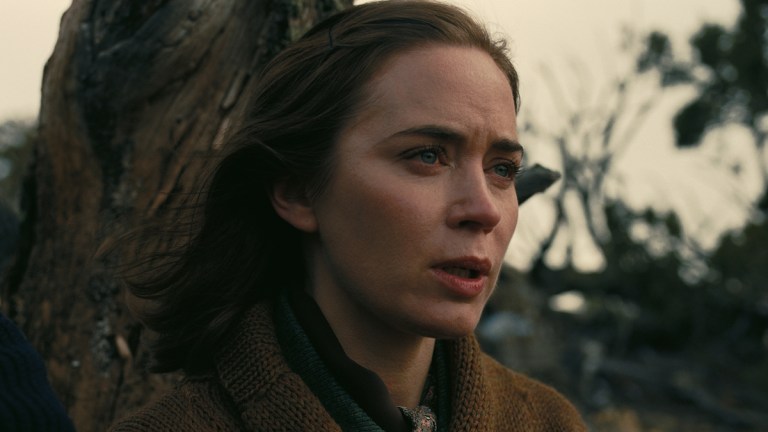The Missing Women of Oppenheimer
Oppenheimer deserves to win Best Picture, which only makes its most glaring flaw more apparent.

This Oppenheimer article contains spoilers
Christopher Nolan’s Oppenheimer is a towering achievement. Ambitious, thoughtful, and often frightening, it’s one part biopic, one part cautionary tale, and one part lament for a world in which humanity’s most brilliant moments of creation are also inevitable acts of destruction. Grounded in a sensational central performance from star Cillian Murphy and an unflinchingly vivid directorial vision, it snagged 13 Oscar nominations and deserved every one. It’s not perfect, by any means, but it’s a sprawling, cerebral reminder of what blockbuster filmmaking looks like on almost every level. It’s probably going to win Best Picture, and it’s hard to argue that any other movie that came out last year can—or likely should—beat it.
It’s precisely because Oppenheimer is such a genuinely great film that its most glaring flaw feels all the more frustrating. If Nolan and company didn’t get so much else right, from the technical wizardry of the Trinity explosion to the throat-closing dread that infuses so much of what comes afterward, as both characters and viewers realize the nightmarish potential of what Oppenheimer and his merry band of scientists have unleashed, its missteps wouldn’t be quite so glaring. Instead the movie’s overall excellence only serves to further underline how wrong it gets what should otherwise be one of the story’s strongest elements: its women.
Perhaps this shouldn’t come as much of a surprise. For all of Nolan’s obvious talent and vision, his movies tend to feature severely underdeveloped female characters, when they bother to have women in them at all. (Dunkirk, it should be noted, does away with this problem by simply not having any named female characters onscreen!) His films are largely populated by dead wives, dead love interests, and women who need rescuing, with an occasional quippy (sometimes sexy) sidekick thrown in for fun. The one real exception to this is Interstellar, but even its female leads are largely defined by the men in their lives and the film doesn’t pass the Bechdel Test.
Despite the real-life basis of its story, Oppenheimer is also not immune to this problem. In fact, you might be surprised to learn how many women were involved in the Manhattan Project, given how few female characters appear in this movie. From mathematicians and physicists to librarians, medical staff, and administrative workers, women comprised over 10 percent of the residents at Los Alamos. (Which, thanks to the size of the project, numbered well over 600 people.) Though these women weren’t exactly household names in the same way that, say, Leo Szilard, Edward Teller, or Isidor Rabi were, that doesn’t make their contributions—or the fact they were present!—any less important or worthy of acknowledgment.
Experimental physicist Chien-Shiung Wu helped develop the process for separating uranium which confirmed Enrico Fermi’s theories about beta decay. Nuclear physicist Maria Goeppert Mayer, who would go on to share a Nobel Prize for Physics in 1963, worked alongside Teller on isotope separation. Mathematician Naomi Livesay played a key role in the calculations that made the Trinity Test possible. But despite the presence of literally hundreds of women—and a literal baby boom— Nolan’s Los Alamos is a heavily male-coded space. Female chemist Lilli Hornig, who worked on plutonium research, does appear briefly onscreen and is played by Olivia Thirlby but makes almost no impression, reduced to making occasional jokes about not knowing how to type and the female reproductive system. (Trust me, I wish I was kidding.) The rest of the film’s women are, for the most part, given little to do beyond performing domestic tasks or cheering on the accomplishments of the men in their lives.
Even the film’s two meatiest female roles are conceptualized almost solely around their romantic relationships with J. Robert Oppenheimer (Cillian Murphy). Florence Pugh’s Jean Tatlock was a psychiatrist and writer who was responsible for much of Oppenheimer’s introduction to radical politics, yet the film is more interested in the idea of her as an emotionally unstable ex with mental health problems. (Or speculating about the manner of her death.) What a waste of Pugh, whose most memorable moment onscreen is the sex scene that provides a reason for Oppenheimer to recite his famous quote from the Bhagavad Gita.
Sadly, Oppenheimer’s wife fairs little better. The real Kitty (who is played by Emily Blunt onscreen) was a talented biologist with a complicated romantic history of her own. Still, her unhappiness in Los Alamos is painted with the broadest of strokes and lacks anything that might be called nuance. She’s obviously miserable, struggling with what appears to be postpartum depression, drinking heavily, and determinedly ignoring the wails of her newborn child. But the film isn’t all that interested in granting her the interiority to explore any of those feelings or experiences.
To her credit, Blunt makes the most of the underwritten material she’s given. Heck, she basically landed a Best Supporting Actress nomination on the strength of her powerhouse performance in the scene where Kitty testifies at Oppenheimer’s hearing, finally showing just how much more capable she is than the majority of the men around her. But that’s one sequence in a movie that clocks in at three hours, and as great as it is, it’s also an uncomfortable reminder of how much more Nolan could have done with Kitty’s character.
Over the course of the film, we see Oppenheimer interact with many of the leading scientific minds of his day, building relationships with these men that range from friendly and competitive to downright antagonistic, and with most boasting a depth that’s rarely granted to his relationships with any of the women in his life. What’s worse, neither Kitty nor any of the film’s other female characters are given the same sorts of bonds with one another, and it’s difficult to remember whether any of them are even granted opportunities to do something as simple as have regular conversations.
To be fair, no one is arguing history should be rewritten to place women at the center of this seismic event—or any other in which they did not take part. But it doesn’t seem like too much to ask that Oppenheimer acknowledge women were part of the story of the Manhattan Project or that its existing female characters had lives and desires that existed independently of the man at the center of this story. Instead the women of Oppenheimer tend to feel like afterthoughts at best and ghosts at worst, figures who haunt the edges of a story they’ll never truly affect and who only occasionally feel part of it. What kind of movie might the best film of the year have been if it had also given actresses like Blunt and Pugh the depth they deserved?
